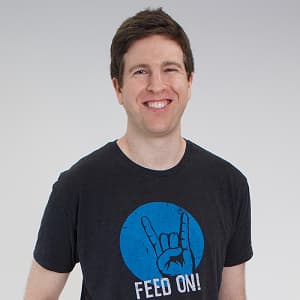Andrew Cooper is a Sr. Manager of Ecommerce at Metric Theory. He leads the Ecommerce team, delivering feed management and Amazon ad services while setting shopping and PLA strategy for the agency.
What major changes have you seen across the e-commerce digital marketing landscape in the last few years?
In my mind, there have been three interrelated shifts that have changed e-commerce involving business strategy, branding, and user experience.
1. E-commerce businesses need to be diversifying their channel mix more than ever before and considering a full-funnel approach. Finding optimal budget allocation is not an easy process, but those doing it right are seeing huge benefits, especially retail brands going direct-to-consumer. Platforms like Facebook are table stakes now, but it was only a few years ago that our e-commerce clients were relying almost solely on Google and email to drive business. And with Facebook becoming so competitive so quickly, every e-commerce business needs to consider their approach to Instagram, Pinterest, and even programmatic display and emerging platforms like Reddit and Quora to stay competitive. It’s become so much more complex so quickly.
2. With those shifts, attribution and performance evaluation needs to evolve, with more e-commerce businesses thinking in terms of new customer acquisition rather than just ROI on a per-sale basis. We do a lot of business consulting for our clients on setting goals for each channel, because it’s not realistic to compare the results for each in a head-to-head manner. They’re working together for a maximized end result, and each plays a different role in the purchase funnel. As path-to-purchase gets longer, considering how much weight to give each touchpoint and what technology to use for analyzing performance will determine how prepared you are to compete for the next 10 years of e-commerce as the market continues to consolidate.
3. E-commerce ad media has become much more visual. Whereas just getting onto Google Shopping or launching product listing ads was a ticket to strong returns a few years ago, we’re already in a place where investing in the photography and presentation of a product is a key success component. As advertisers expand, YouTube, Facebook, Instagram, and Pinterest all focus much more on this same visual appeal component. To pull buyers away from Amazon into your own experience, credibility and quality signals are incredibly important, and it starts with that first ad.
What advice do you have for brands advertising on Google Shopping or Amazon?
I’ll separate the two, because I believe they both play a huge part in e-commerce success and need to be treated differently.
Amazon Ads
To us, it isn’t an option to ignore selling on Amazon anymore. The pure revenue opportunity it provides and access to buyers is undeniable, and if you’re not there, then your competition or a reseller is probably reaping the benefits. However, goal setting is huge for Amazon because a purchase on Amazon isn’t equal to a purchase on your site. You need to consider the cut Amazon takes, the impact of not getting customer-level insight, and the likely reduction of customer lifetime value when setting goals.
Google Shopping
Here are three optimization activities that should be active for every advertiser. If you’re not hitting all of these, then you’re missing revenue opportunities.
1. A/B Testing product titles and images. Many advertisers take these as static pieces of their ads, but they don’t have to be. If you found out zero ad copy tests had been run on your text or display ads over the last year, how would you feel? Have the same mentality with titles and images, because outside of price, they have the highest impact on whether a searcher chooses to click through and consider buying.
2. High-value and low-value search term filtering. Searches like brand and product/manufacturer searches have inherently different value than generic searches. If you don’t have 3+ campaigns to accomplish this, then you’re missing a huge lever to pull to maximize spend on your most profitable searches.
3. Product segmentation, without over-granularization, for proper bid control. If you have too few product groups, start by getting to a point of having less than 50% of your spend going to product groups with 100+ products. If you have every product broken out without getting much traffic or conversion data going to the vast majority, start grouping them up by category, aiming to have each group have at least 10 conversions/month. These two measures ensure that when you run bid adjustments, you have adequate data to make smart bid changes.
Where do you see the digital marketing landscape for ecommerce in the next few years?
Improving full-funnel budget decision making. We’ve made this a large focus for our clients, because of the amount of business impact we’ve seen for clients we work with who’ve embraced it. It starts with moving off of last click attribution, and we’re now asking them to look much higher in the purchase funnel. There‘s a learning curve, but we think it’s unavoidable for businesses to compete in the ecommerce market for the next 10 years.
As always in digital marketing, we see new channels, new ad types, and new technology in general as opportunities. The last two years have seen Amazon, Instagram, and Pinterest all explode in terms of opportunity, and YouTube is becoming a real factor for direct response in more categories. The innovation cycles seem to be getting shorter, which is making the channel mix much more complex really quickly.

What is one of the best or the most worthwhile investments that you’ve made?
Any time I’ve spent investing in learning new areas of marketing has given me a huge return. I mean, I love digital marketing, but it‘s also helped me better understand the advertisers I work with more, and it’s strengthened my relationship to them and what I’m able to offer Metric Theory overall. If something comes up in chatting about a client’s business or among our ecommerce team, I’ll just Google it until I feel like I’ve fully absorbed it.
What advice would you give to a smart, driven college student about to enter digital marketing?
I’m a bit biased, but I’d advise them to go work at an agency. There’s nothing that will teach you so much, so fast, simply based on the number of businesses you touch and the problems you’re solving. Make sure that you feel really good that the agency is focused on your career growth and learning opportunities, though. Also, look for people who nerd out on their subject matter. Your own knowledge will grow so much faster being surrounded by others who are passionate about the work. In-house positions have other positives to offer, but getting broad exposure to a variety of clients, channels, and ad types early on at an agency will set you up with the knowledge you need to work in a lot more roles in the future.

Brian Roizen is the Cofounder and Chief Architect of Feedonomics, a full-service feed optimization platform that optimizes product data for hundreds of channels. He has been featured on numerous podcasts and eCommerce webinars, and regularly contributes to Search Engine Land and other industry-leading blogs. Brian graduated summa cum laude from UCLA with both a Bachelor’s and Master’s degree in Mechanical Engineering.



